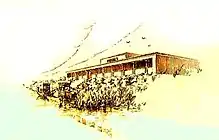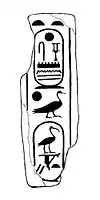Deir el-Ballas
Deir el-Ballas is an archaeological site in Upper Egypt. It was the location of a royal palace and administration center occupied by rulers of the Seventeenth Dynasty in ancient Egypt's late Second Intermediate Period.
Location
Deir el-Ballas was "strategically located at a bend in the Nile" on its western bank,[1] approximately twenty kilometers south of Dendara [2][1] and just north of Thebes (modern-day Luxor).[1]
History
The complex was "a short-lived royal city-palace built by Theban kings as a military base for imperial campaigns against the Hyksos, a group of foreign rulers who had taken control of northern (Lower) Egypt during a period of national weakness at the end of the Middle Kingdom."[1] Which of these kings built it in which dynasty is not yet known.
"A collection of inscribed potsherds, or ostraca, were recovered from Deir el-Ballas. These confirm that the forces for the attack on the Hyksos capital were marshalled here, and describe the large quantities of goods and personnel that were brought to the site, including cattle, men, possibly weapons, and a roster of ships and their crews. The Kamose Stela....mentions the assembly of the Theban fleet at a place called Per-djed-ken, which may well be the original name for Deir el-Ballas; another text mentions a royal residence at Sedjefatawy that belonged to Ahmose, the Theban king credited with driving out the Hyksos."[1]
"With the success of the Thebans, the city-palace at Deir el-Ballas was no longer necessary, and was swiftly abandoned."[1] However, the surrounding area continued to be used for a short time as a burial ground, as cemeteries were discovered "dating to the late Second Intermediate Period and the early 18th Dynasty, during the second half of the 16th centuries BC."[1]
Structures

Deir el-Ballas consisted of several facilities-- the North Palace, the South Palace, and "clusters of habitation...located north and south of the central [North] palace"[3] The latter included a workman's village,[4] an administrative quarter "and a number of private houses, which ranged in size from small two-room huts to large 'villas'"[4][3] Peter Lacovara provided information on these at length in the September 2017 issue of Current World Archaeology:
"The royal residence--North Palace – was built at the midpoint of a large semicircle of limestone cliffs that border the low desert, with clusters of residential buildings to the north and south of it...The full size of the settlement is unknown, as the eastern end of the site, which extends into agricultural land, remains uncovered. However, at least 45,000m2 of the North Palace and its enclosures have been recorded... The palace itself is made of unusually large mud bricks, about 54cm × 27cm × 18cm, and comprises a series of columned courts and a long entrance hall, grouped around an elevated central platform. This platform was constructed on casemate foundations: long mud-brick chambers filled in with rubble and capped by a brick pavement. Some of these casemates survive to a height of about 5m. They once supported the raised private apartments of the palace, which would have given it the appearance of a fortified 'Migdol’ tower."[1] Lacovara notes elsewhere that "the palace was decorated with wall paintings of armed men carrying battle axes,[5] and faience tiles, fragments of which were recovered by the Hearst Expedition." [4] According to author Margaret Bunson, "the palaces (pero or per-a'a) (of the Second Intermediate Period) always contained two gateways, two main halls, and two administrative sections to reflect the upper and lower regions of the nation. Flagstaffs were used at the gates, as they were placed before temples. The remains of the Seventeenth Dynasty (1640–1550 BCE) palace at Deir el-Ballas, on the western shore north of Thebes, indicate somewhat luxurious surroundings and innovative decoration, following the "double" scheme. In some instances the walls and floors were designed to portray pools of fish and vast tracts of flowering shrubs."[6]
As for the workmen’s village, it was situated apart from the main settled area. [1] "A series of roughly built stone and mud-brick structures, consisting of one or more courts connected by short flights of stairs, were cut into the hillside. They closely resemble the layout of chapels found in the workmen’s village at Amarna."[1]
Finally, "the southern extent of the settlement at Deir el-Ballas was marked by a large, rectangular mud-brick platform. Reisner [head of the Hearst expedition in 1900-1901] called this the ‘South Palace’, but it is clearly non-residential in character. Situated at the top of the hill, far from the rest of the settlement, it enjoyed commanding views of the Nile and surrounding countryside. The building has a wide terrace, fronting an elevated platform measuring about 40m wide and 150m long, with a broad flight of stairs leading to the top. Though the upper section of the platform, which has been all but destroyed by centuries of looting, probably supported reed structures or tents rather than a substantial construction. The design and location of the ‘South Palace’ suggest that, rather than a palace, it was an observation tower, keeping watch over the river and the southern approach to the settlement, and monitoring traffic entering the settlement. It was also an ideal post from which to watch the movement of the Theban fleet."[1]
Excavation

Deir el-Ballas was excavated from 1900 to 1901 by a University of California team, sponsored by Phoebe A. Hearst and led by George Andrew Reisner [2] [4] "These excavations uncovered a large royal palace, a settlement, and a series of cemeteries dating to the late Second Intermediate Period and the early Eighteenth Dynasty;" however, expedition records neither proved adequate enough for understanding [2] [4] nor were ever compiled for publication. (The Ancient Egyptian Heritage and Archaeology Fund, however, received a grant to accomplish this in the 2010s from the Shelby White and Leon Levy Program for Archaeological Publications.[7] As of 2017 all of the items from the Hearst expedition had been documented save for the collection stored at the Phoebe A. Hearst Museum of Anthropology, University of California; once this work is completed a draft manuscript will be composed and sent for final editing and publication.[7])
"In order to clarify the records of the expedition and enable publication of the site, four seasons of survey and clearance were undertaken in l980, 1983, 1984 and 1986 by Peter Lacovara under the sponsorship of the American Research Center and the Museum of Fine Arts, Boston." [2] [4] Their findings "revealed a site far larger than the Hearst expedition records had indicated, including palace complexes, a group of large houses, and remains of a previously unrecorded ancient settlement."[2] "In addition to the large number of houses and other domestic structures, there appears to have been a group of memorial chapels similar to those recently excavated by The Egypt Exploration Society at Tell el-Amarna, and possibly an administrative quarter, also corresponding to Tell el-Amarna. At the conclusion of the survey seasons, a preliminary report was published under the auspices of the American Research Center in Egypt."[4]
Some significant items discovered in this area include a carved limestone block inscribed with the name of the pharaoh Djehuti from the Second Intermediate Period[8] and the Hearst papyrus, a Middle Kingdom-era medical text discovered in the area by an Egyptian peasant around the turn of the 20th century.[9]
According to Peter Lacovara, "In more recent years, the growth of the modern village and the construction of a number of roads along the desert edge, along with looting that occurred during the revolution in 2011 has threatened to destroy a significant part of the site."[4]
For two weeks in January 2017, Lacovara led an expedition "consist[ing] of a theodolite survey, photography and planning to assess the condition of the site, the perimeter of the antiquities area and possible ways to protect and conserve the site."[10] The team returned January 2018 seeking to repair a wall at the South Palace, fill in casemates at the North Palace, clear the sites of trash, and place signs and fencing around the dig sites to deter further damage.[10]
References
- "The Egyptian empire strikes back : Peter Lacovara tells CWA why this city-palace must be preserved" (PDF). Ancientegyptarchaeologyfund.com. Retrieved 13 September 2018.
- "Deir el-Ballas Preliminary Report on the Deir el-Ballas Expedition, 1980-1986 | American Research Center in Egypt". Arce.org. Archived from the original on 2015-01-18. Retrieved 2018-02-26.
- "The 2017 Season at Deir el-Ballas" (PDF). Ancientegyptarchaeologyfund.com. Retrieved 13 September 2018.
- "Deir el-Ballas- Full History – The Ancient Egypt Heritage and archeology Fund". Ancientegyptarchaeologyfund.com. Retrieved 13 September 2018.
- P. Lacovara, “Archaeological Survey of Deir el-Ballas,” ARCE Newsletter 113 (1980). pp. 1-7.
- "Infobase Learning - Login". Fofweb.com. Retrieved 13 September 2018.
- "Deir el-Ballas Publication – The Ancient Egypt Heritage and archeology Fund". Ancientegyptarchaeologyfund.com. Retrieved 13 September 2018.
- Christina Geisen, Zur zeitlichen Einordnung des Königs Djehuti an das Ende der 13. Dynastie, Studien zur Altägyptischen Kultur, Bd. 32, (2004), pp. 149-157
- "The Hearst Medical Papyrus". 2003-12-10. Archived from the original on 2003-12-10. Retrieved 2018-02-26.
- "Deir el-Ballas Fieldwork – The Ancient Egypt Heritage and archeology Fund". Ancientegyptarchaeologyfund.com. Retrieved 13 September 2018.
External links
- "* Ägypten-Reiseforum * Isis & Osiris * Aegyptenreiseforum * Ägypten Urlaub * Aegypten Reise * Ägyptenforum *". Isis-und-osiris.de. Retrieved 13 September 2018.
- "LC Linked Data Service: Authorities and Vocabularies (Library of Congress)". Id.loc.gov. Retrieved 13 September 2018.
- Richard A. Parker, Journal of the American Research Center in Egypt, Vol. 2, (1963), pp. 113–116. Published by: American Research Center in Egypt.JSTOR 40000975
- Peter Lacovara, The New Kingdom Royal City, Routledge 2013. 256 pages. ISBN 978-1-136-16817-8.